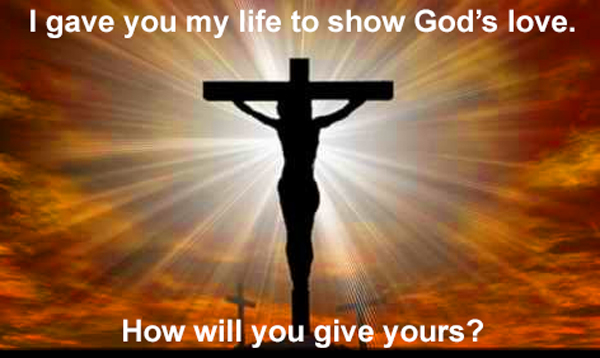Jesus Goes to the Cross
Rotation.org Writing Team
Video Workshop
Summary of Activities
Students will view two free video clips, one from the "Children's Version" of the Jesus Film which retells the story of the Cross, and a second "short film" that reflects on our response to Jesus' death on the Cross. This lesson also includes an alternate animated video selection, and an alternate storytelling activity for the reflection or for those with more time.
About the Videos
We have looked at over two dozen videos that depict the story of the Cross. Our choices are informed by our desire for accuracy with a sensitivity towards children. Many good and favorite videos are simply too graphic for kids when depicting the trial and crucifixion. See the post after this one for a list of available videos about the Cross we do not recommend (and why) and some other options.
The Main Video:
We recommend that you show a 16-minute section from the "Children's version" of the famous "Jesus" film. You can view it online for free, or you can download it for free by clicking the page's download link. Once downloaded, you can copy it to a USB flash drive or burn it to a DVD for viewing on a computer or with a DVD player. See the lesson plan for time marks.
If you prefer an animated version of the story of the Cross, we suggest chapters 5-8 of Nest Family's "Worthy is the Lamb" DVD. The drama and characterizations can be a bit intense, but Jesus' death on the cross isn't very graphic (and that may not be a good thing for older children who need to understand the agony of Christ). You can see a low-resolution preview of it on YouTube here.
We chose the Jesus Film because of its dramatic quality, scriptural accuracy, and because it is one of the less bloody and graphic depictions of the crucifixion. It does show Jesus being taunted, having the crown of thorns shoved onto his head, and his hand being nailed, but is far less gruesome than most Jesus movies. If those scenes are too much for you or your age group, hit the FF on your remote. See the Bible Background's discussion about the violence of the cross and both the necessity and sensitivity with which we need to share this challenging story with children.
The Reflection Video:
"Palm Sunday" is an award-winning short film that tells the story of two brothers in a Holy Week worship service where they are hearing the story of Good Friday. The younger brother has a life-changing encounter (vision) with Christ on the cross. It too can be viewed online or downloaded from its YouTube page. (Though the site said it was also available for purchase, we could not find a working purchase link.) See the lesson notes for more details.
Please preview this short film if you are going to use it with first and second graders. It does very briefly show Jesus in agony on the cross in quick and dimly lit vignettes. They may be disturbing to some young children (and may go unnoticed by others). They are there to move the brother to confess, "I did this to you," and give him cause to thank Jesus. See the Bible Background's notes about "the violence of the cross" and children.
Scripture for the Lesson
Mark 15:1-47 is this set's scripture, but as in many Video workshops we have to work the version that the film uses. The JESUS film is a combination of Gospel accounts. Most notably, it includes the "Luke only" stories of Jesus before Herod (Luke 23:8f), “Father, forgive them, for they do not know....” (Luke 23:34), Jesus' promise to the robber being crucified (Luke 23:40f), and Jesus final words: “Father, into your hands I commit my spirit” (Luke 15:46).
As sometimes is the case in the Video Workshop, we are going to let the video be our "Bible Reading" for this lesson. The Jesus film sticks closely to scripture.
Key Verse for Understanding the Cross: "God demonstrates his own love for us in this: While we were still sinners, Christ died for us." (Romans 5:8, NIV. See the Bible Background for more info.)
Discussion Verse for the Reflection: "God showed his love for us by sending his only Son into the world, so that we might have life through him. 10 This is what love is: it is not that we have loved God, but that he loved us and sent his Son to be the means by which our sins are forgiven. 11 Dear friends, if this is how God loved us, then we should love one another.1 John 4: 9-11
Lesson Objectives
See the Bible Background at rotation.org for this set's complete list of objectives.
Preparation and Materials
- Read the Bible Background and scripture.
- Prepare to view online or download the free high-def version of "Jesus" -the Children's Version at the Jesus Film website.
- Prepare to view online or download the free "Palm Sunday" film about the two brothers in worship.
- Bring half a dozen large nails to use in the Reflection activity.
- Print the attached PDF that contains the picture for the lesson opening, and a handout for the reflection film.
- Print the alternative storytelling script for the Reflection.
- See "Connecting to the Web & Download Helps" at the end of this lesson.
Lesson Plan
Open
Welcome your students and explain what they'll be doing and learning in today's lesson.
Show them the black and white picture of the cross in this lesson's printable handout and ask them to explain what it means. Tease them by saying that "these people outlined here might just be the most important people who ever stood at the foot of the cross." Answer⇒ It's me, it's you, it's us. When we study the crucifixion of Jesus, we are not just studying an event that took place 2000 years ago, we are supposed to transport ourselves to the foot of Jesus' cross, ...to look up in his eyes and understand what he is trying to show us.
Show the Jesus Film (Children's Version)
Alternately, you may show chapters 5-8 of the Worthy is the Lamb DVD (Nest), the animated retelling of the story of the Cross.
Share these "two questions they'll answer at the end of the video":
- If you have been one of the children watching what was happening to Jesus, what would you have said or done to save Jesus? How would Jesus have answered you?
- What does Jesus' sacrifice on the cross "demonstrate" to us (show us, reveal to us) about God's heart? The extent of God's forgiveness?
Now Show the Jesus Video:
Explain what the class is about to see, then show the first 1:43 minutes of the video which introduces and explains who the children are in this "children's version" of the Jesus film. Stop at 1:43 (just before the angel's announcement) and explain to your class that you're going to jump ahead to the 37th-minute mark where they will see the father of one of the children receiving word that Jesus has been arrested and taken to see Caiphas the High Priest. The children will continue to appear throughout the remaining 22 minutes of the video.
End viewing this video at the sunset scene at 53:40 mark-- just after the scene where the boy tells his friends about the promise of the Resurrection (or continue to the end if you have plenty of time.) Total recommended video time: approx 18 minutes.
Have students now answer the questions you shared before you started the video.
Reflect with the Palm Sunday short-film
The lesson handout has an outline and quotes from the movie. An alternate or extended time storytelling version of the video is also available as a printable script.
Explain to your students what they are about to see—a short video about two brothers going to a Holy Week worship service. The story comes fast, so explain ahead of time the story's premise and setting so that they catch it's meaning the first time through. See note above in "About the Videos".
Explain that after the video, you are going to ask them to "come up with a better ending."
Show the "Palm Sunday" video at http://palmsundayfilm.com/index.html. The following version of the video is the same video in slightly lower resolution found on YouTube.
See a younger child alternative to this video at the end of this lesson.
Questions to ask after the video:
- Why do you think the younger brother denied knowing Jesus?
- Why did the younger brother say to Jesus the first time he saw Jesus, “I didn’t do that to you. That was people from 2000 years ago. It’s not my fault that you’re up there.”
- Is it "our fault" that Jesus is up there on the cross? (Yes, when we don't believe or act the way Jesus taught us, we are just as bad as those who put Jesus to death. But God was in Christ showing us that he still loves us, even though we are the ones who deserved to be condemned, not Jesus!)
- What changed the younger brother's heart? (What changes a person's heart is always a bit of a mystery. Perhaps it was because he took Jesus seriously—took the time to look at what Jesus was doing on the cross, and accepted that it was HIS sins that deserved punishment, not Jesus. That he was unworthy.)
Tip: Have some large nails to pass among your students as you discuss this point. It's not easy to see in the film the first time, but the younger brother is HOLDING NAILS when he realizes "I did this to you." Did what?
In the "party vignettes," the younger brother is confronted with some of his sins. The connection is that our sins are like the nails—it was for our sins that Jesus sacrificed himself to demonstrate that God's love does not count our sins against us, but empowers us to change. - What could the younger brother do to change the OLDER brother's mind about Jesus? What can you do to demonstrate to others Jesus' love for them?
Coming up with a better ending: "Saying more than just THANK YOU"
At the 3:08-minute mark, the Palm Sunday film displays John 3:16 "For God so loved the world..." Following this, the younger brother says, "thank you" to Jesus and the film ends.
However, imagine that the brother felt compelled to say more than just "thank you" —that he felt compelled to tell Jesus what he was going to do to change his life in gratitude for his sacrifice on the Cross. Invite students to come up with THAT ending to the movie, ...what kind of "promise" could the brother have made?
After a few tries, have students turn to 1 John 4:9-11—one of our key memory verses for this lesson set. Before reading it together, ask them to "look what this passage says our response to Jesus should be."
After reading it, come up with several examples of how a person can love like Jesus loved (sacrificial, unconditional, forgiving).
Roll the movie back to the 3:10 minute mark and before you show that scene (of the younger brother taking Communion), ask your students "what are some of the things Jesus GIVES us to become more like him?" (Answer: it's in the film starting at the 3:10-mark when the brother takes the bread believing in Jesus and shares what he believes with his older brother.)
Closing
Close by drawing a large cross on the board, then as you say the following, draw a large question mark over the top of the cross.
In today's lesson, you have heard the story of something that happened 2000 years ago in a faraway land. But the big question mark is whether or not YOU believe it, and if you do, what are you going to DO about it? Jesus gave his life to show (demonstrate) God's love. How will you give yours?

Adaptations
For Younger Students:
In the Jesus Film, explain who the children are in the video. Remind them where we are in the Jesus story. The Palm Sunday reflection video about the two brothers may be confusing to all students if you don't tell them what they are about to see, especially the quick and dimly lit vignettes showing Jesus.
A storytelling alternative to the Palm Sunday film:
While you may conclude that the quick graphic portrayals of Jesus in the short film are okay to use, you may conclude that the concept of the film is too complex for your younger crowd. So here's a storytelling version of the video that gets at the same idea—that the crucifixion of Jesus forces us to consider the agony he suffered at the hands of sinners like us, and the love Jesus demonstrated in spite of our unworthiness.
You will assemble three actors: two brothers standing next to Jesus who is standing on a chair with his arms outstretched in the shape of a cross. Use the storytelling script attached to this lesson. (You may want to create a video of this with your cellphone.)
For those with more class time:
Use the Storytelling Version of the Palm Sunday film to create a video of your own.
Notes and Sources
Connecting to the Web in Your Classroom:
If you want to view the online versions of these two films, you can do it by connecting to the internet via your laptop, tablet or cellphone. Yes, your cell phone can connect to a modern TV and be how you stream these videos to the screen for your students! Learn more.
Download Help:
The Children's Version of the Jesus Film has its own download link. The "Palm Sunday" video of the two brothers in worship is available for streaming at their site or on YouTube at this URL: https://youtu.be/Y3Vor55BoE0 You can copy that URL and paste it into this converter website to create a downloadable MP4 file of the film for you—which you can then burn to DVD and play on your classroom DVD player. If you need help, let us know.
Written by Neil MacQueen for the Rotation.org Writing Team
Copyright 2018, Rotation.org Inc.





